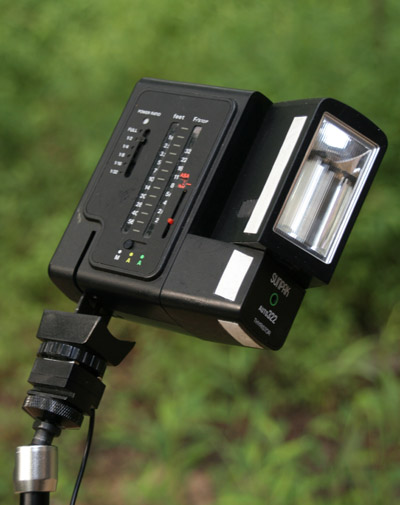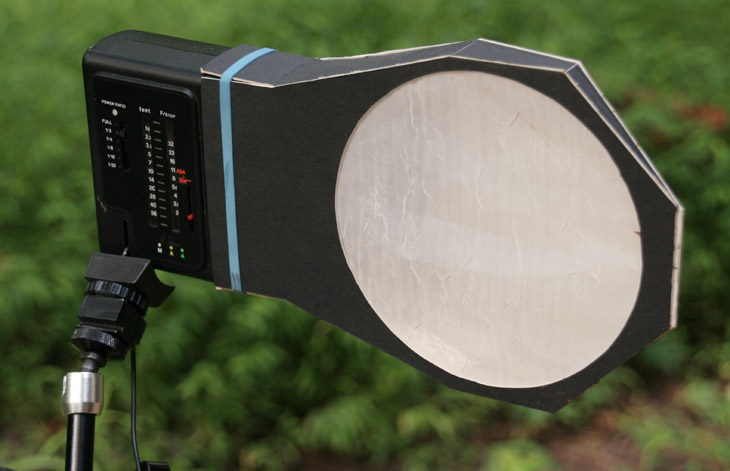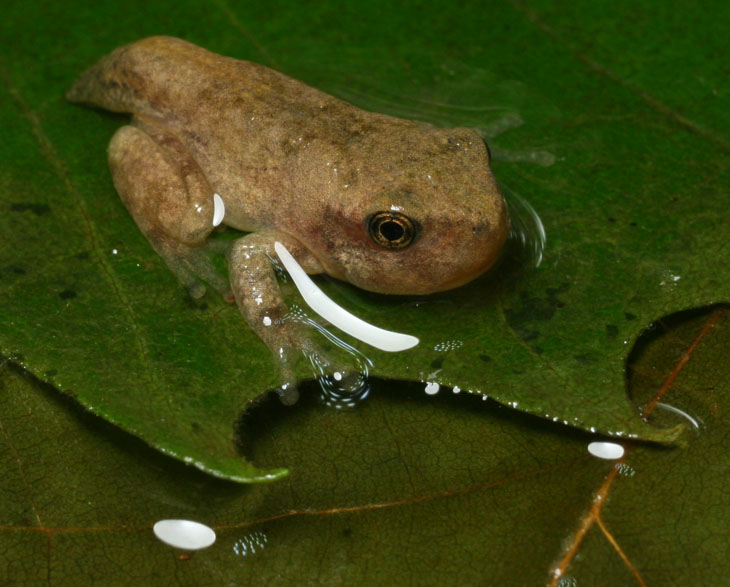In the part nine post, I talked about having to create a new method of portable macro lighting because I trashed my old method, and while this was functional, there were a few small problems with it. The coverage was a little narrow and specific, while being hard to aim, and it sometimes produced odd reflections. But the worst bit was the weight. The Metz 40 MZ-3i is a wonderfully capable flash unit, but balanced it’s not – it’s fairly heavy, and it suffers from a decision made decades ago that few have yet addressed, which is the position of the hot shoe on a camera. Sitting right atop the prism housing and so directly in front of the user’s forehead, a flash unit cannot extend backwards from the shoe mount or it will interfere with putting one’s eye to the viewfinder; that leaves left or right (usually interfering with camera controls on the top of the body,) straight up, or out to the front. Many flashes are aligned straight up, but the Metz goes out to the front, which means the weight is mostly away from the mount. This becomes much worse if you try to mount the flash on something like a small ballhead or anything else that allows precision aiming, because off-center weight requires a lot of friction to stabilize, and most small ballheads can’t cut it.
On an off-again, on-again basis I looked for other solutions, mostly the idea of a much smaller and lighter flash unit that could still do manual output; this has not been a priority among manufacturers. To paraphrase their typical thinking, if you want manual output, you must be experienced/professional, and you’ll want a lot of other bells & whistles too and will be willing to pay a shitload of money for a lighting unit. There’s one exception, the MeiKe MK-300, but the reviews of it aren’t so hot. Did no one, ever, make a small manual-output flash unit?
 The webbernets is great, I have to admit. Yes, someone did make one at one time, and it turns out to be the same manufacturer as my previous flat-panel flash: Sunpak. The Sunpak Auto 322, while long discontinued, is a flexible little unit with a bundle of aiming options, a built-in PC sync cord, and manual output ranging from full to 1/32nd power, as well as thyristor-controlled automatic exposure. It can flop 180° atop the shoe mount, sitting to the left, right, or vertically, and the smaller flash head can pivot 180° on its own, as can be seen in my image. It is a little bigger than palm size but about half of the weight of the Metz and much better balanced. It runs off four AA batteries and has a Guide Number of 24m/80′ – not the strongest flash you’ll find, but more than adequate for macro work.
The webbernets is great, I have to admit. Yes, someone did make one at one time, and it turns out to be the same manufacturer as my previous flat-panel flash: Sunpak. The Sunpak Auto 322, while long discontinued, is a flexible little unit with a bundle of aiming options, a built-in PC sync cord, and manual output ranging from full to 1/32nd power, as well as thyristor-controlled automatic exposure. It can flop 180° atop the shoe mount, sitting to the left, right, or vertically, and the smaller flash head can pivot 180° on its own, as can be seen in my image. It is a little bigger than palm size but about half of the weight of the Metz and much better balanced. It runs off four AA batteries and has a Guide Number of 24m/80′ – not the strongest flash you’ll find, but more than adequate for macro work.
Now, all that’s well and good, but the secret to flash photography is controlling the spotlight effect, and that means a reflector/diffuser. After a lot of careful measurements and a bit of cutting and gluing, I’d created an attachment out of black matboard (so, dense cardboard,) aluminum foil, and a sheet of almost sheer white material. The entire inner surface is coated in foil and thus reflective, all exiting from the round opening with the sheet of white material to diffuse the light a bit more. While it increases the size of the flash quite a bit, it still remains manageable and is only slightly smaller in output surface that the flat-panel flash unit, while producing a round light source. Those thick white stripes you see in my image are patches of slightly tacky vinyl, glued to the tapered head of the flash to give my softbox more purchase. All together, it looks like this:

The top surface slopes down to a point at the front, allowing the light to bounce down through the opening, while the opening itself is far enough from the flash head that there is no chance of direct light hitting the subject – this prevents strong highlights in reflections from eyes, for instance. The round shape is more natural-looking in those same reflections, and the opening is 13cm across, so big enough to provide wide coverage for most macro subjects. Instead of being a spot source like a flashlight or spotlight, the light comes from the entire surface and provides more coverage and softer shadows. Most importantly, it’s easily portable, and light enough to position in countless ways.

Being offset to the side like this, a heavy flash unit is quite noticeable, so this lighter rig is a lot more manageable. It’s mounted on a seven-inch “Magic Arm,” a slick little mount with two ballheads and a pivot joint in the middle, all tightened by just one knob – lots of positioning options, but ridiculously overpriced unless you shop around a bit (*cough* Chinese Ebay listings *cough*.) The grey thing spanning between the camera and flash unit is, of course, a Manfrotto 330B macro bracket seen in part one.
The real test, naturally, is how the images taken with this lighting rig look, and I’ll let you judge for yourself, since it was used exclusively for the images in this post, and this one, and this one, and this, and even this (the first image excepted – that’s natural light.) I’m pleased with it, even though I may add a small fill-reflector to help balance out those shadowed areas opposite the light unit.
But, I made a passing mention a little earlier of how studio macro work can still go wrong, so let’s take a quick look at one of the more amusing, though bizarre, examples. I had captured two tiny amphibians and was shooting them in a shallow tray on the back porch, using some leaves a a natural setting. I had provided a thin layer of water to keep my subjects moist and support the typical conditions, and highly reflective aspects of the setting or subject can be a problem at times. In this case, I was using a gooseneck LED desk lamp for focusing, throwing a lot of light to help nail optimum sharpness (for instance, when using the reversed Sigma 28-105 with its fixed aperture of f16, which makes the viewfinder image quite a bit darker than normal.) There’s such a thing as the wrong angle, though:

That long solid reflection over the foreleg is bad enough, but the colander effect from the LED lamp is just hideous, and a bit surreal. The only use such an image could be put to is a blog post on lighting failures so, uh, yeah…




















































